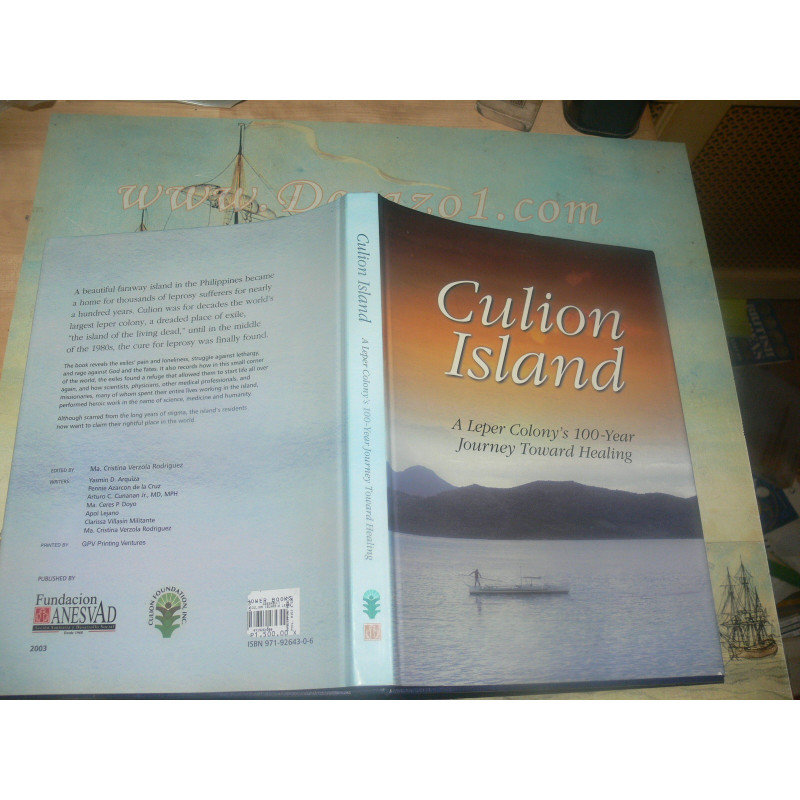












Arquiza, Yasmin D.
Culion Island
A Leper Colony's 100-Year Journey Toward Healing
Philippine, Culion Foundation. 2003. Hardcover. 188 p., illustrated
For Condition, Index, and more details see photos.
Word spreads in the barangay that the sanitario is coming. You feared this day, ever since those patches started to appear on her arms. At first, they were easily covered under a bell-sleeved camisa, but when a pale lesion broke out on your seven-year-old daughter’s once smooth face, you decided to keep her home from school. She also had to stop attending mass. Nobody knows anything about the condition, but the village priest says that it is God’s punishment upon sinners, upon the unclean and their children. The neighbors whisper that she was nakulam. But it is the government who renders the final judgment: she is a criminal, and she must be taken to the Island of No Return.
It was the year 1907 and the Philippine Commission passed into law Act 1711, which gave the Health Director almost total control over what was considered to be the unbridled leprosy problem in the Philippines. The Americans were in control of the country, and the image of Manila as a “pest-hole of filth” and of Filipinos as dirty and unhygienic justified continued American presence under Governor General William Taft, who was tasked to "clean up" the country.
There were at least 5,000 people who were thought to be afflicted with leprosy at the turn of the century, but less conservative reports pegged the number at 30,000. Many hid themselves, but many more also lived out in the open, as beggars, as workers, as beautiful women who would seduce an untainted man with a kiss. Officials were paranoid about the supposed highly infectious tropical disease spreading to American soldiers, who would in turn carry it back to the United States. Without a known cure, containment seemed to be the only solution.
The Director of Health and his authorized agents are hereby empowered to cause to be apprehended, and detained, isolated, segregated, or confined, all leprous persons in the Philippine Islands... It shall be the duty of every Insular, provincial or municipal official having police powers to cause to be arrested... (Act 1711)
Dean Worcestor, the Secretary of the Interior, and Dr. Victor Heiser, the Director of the Health Bureau, chose the sparsely inhabited and isolated island of Culion in Palawan as their project site, to be modeled after the leper colony of Molokai in Hawaii. They built an entire functioning town with separate facilities and quarters for the patients and for those who would care for them—even further segregation in the colony within a colony.
On the island, the people afflicted with leprosy would live out the rest of their lives in whatever sorry sightless, limbless state they degenerate into before death claimed them. Some would try to escape or commit suicide. Many of them went crazy. And yet, life still flourished in the colony. Segregation became the new norm. A new community emerged, one made up of diverse languages and dialects, a microcosmic Philippines. Men, women, and children lived virtually regular lives, working, fishing and tending to farms, going to school, playing musical instruments, watching the Sunday cockfight.
Weight: 1.400 kg. (packaging included)
Combined shipping
After registration (Important) the system automatically calculates the thickness and weight of every letter and gives you the rate for your Country. (If the combined order becomes to thick or heavy for a registered letter by PostNL, you automaticly see the rate for a parcel in your shoppingcart.)
Shipping is based on a 2 kg registered letter/parcel by PostNL, up to 2 kg no extra shipping costs if the books fit in the same letter/parcel.
Europe only: If its cheaper, we ship with DPD parcels (A 10 kg parcel often costs a few Euros more as a 2 kg parcel by PostNL, the standard shipping company) you will get a refund if you paid to much postage!
Shipping Refunds will be given by Bank or PayPal (The system cann't do this automatcally). Look for details under Shipping & Delivery in the Top Bar.
Combined shipping rules:
You have to combine all your purchases in one order, otherwise the system will see the purchases as seperate orders and start again with the basic rate for a 2 kg registered letter/parcel.
If you accidentally place more orders, we will recalculate the postage and give you a refund. We always ship for the lowest possible costs!
We ship Worldwide, if you cann't register or place your order, please contact us by e-mail: decazo1@hotmail.com

Arquiza, Yasmin D.
Culion Island
A Leper Colony's 100-Year Journey Toward Healing
Philippine, Culion Foundation. 2003. Hardcover. 188 p., illustrated
For Condition, Index, and more details see photos.
check_circle
check_circle